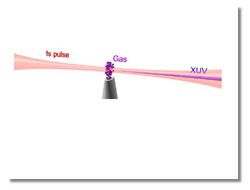 |
|
|
 |
||
| ||||||||||||||
|
Laser-Like Beam May Break Barriers to Technological Progress
Researchers have created a sharply focused, laser-like beam of ultraviolet light using a device that could fit on a dining room table. Scientists and engineers will be able to use this extreme ultraviolet (EUV) light source to measure and manipulate objects at the scale of nanometers (billionths of a meter). Size has been a major hurdle to developing, or even seeing, the tiny components for next-generation computers and nanoscale machines because the objects can be smaller than the waves of light illuminating them. While electron microscopes and other scanning devices can view the small structures, many critical measurements require optical microscopes, and optics are limited by the wavelength of their light sources. A team led by Margaret Murnane and Henry Kapteyn of JILA at the University of Colorado (managed by the university and the National Institute for Standards and Technology) developed the new, short-wavelength light-source with support from the National Science Foundation (NSF) and the Department of Energy. Team member Randy Bartels is lead author of a paper describing the new findings in the July 19 issue of Science. "This pioneering research could have a profound impact on science and technology for years to come," says Filbert Bartoli, a program manager in the NSF Engineering Directorate's Division of Electrical and Communications Systems. The EUV light - which has a wavelength of only tens of nanometers - can pulse in shorter bursts than any other system on the planet (a critical property for measuring fast interactions between small particles) and has a tight focus that is difficult to achieve with other EUV sources. "EUV will share in the richness of opportunities that nanotechnology has to offer, permitting interactions at the level of a single molecule," says Bartoli. As nanotechnology and computer chip manufacture advance, there is going to be an increase in demand for better measurement tools, he says. "We're getting better and better at fabricating these structures, but it does little good if we cannot measure them." The researchers used a process called high harmonic generation (HHG) to produce the EUV light. To achieve HHG, researchers fire a visible-light laser into a gas, creating a strong electromagnetic field. The field ionizes the gas, separating the electrons from their parent atoms. The electrons re-collide with the ionized gas atoms and oscillate back and forth within the electromagnetic field. As a result, a well-synchronized stream of photons fires out of the system, boosted up to a high-energy, extreme ultraviolet wavelength. The end product is basically a multi-megawatt laser (Light Amplification through Stimulated Emission of Radiation) only it was not created through direct stimulated emission of radiation. The EUV beam is so focused that, in the right system, it could produce the smallest diameter laser-like beam in the world - 20 to 30 times smaller than a more common helium-neon laser and several hundred times more intense. As an example, says Kapteyn, "A beam in the EUV that starts as one centimeter in diameter at Earth would be about 30 meters in diameter by the time it propagates to the moon - compared to one kilometer in diameter for a conventional laser." Pre-existing EUV lasers are more powerful, and are better for certain applications. However, in the other laser designs the properties of the gas change during HHG and the light does not stay tightly focused. A variety of factors, including beam pulses that are too long, can worsen the effect. The JILA team used a visible-light laser that can fire in bursts as short as a femtosecond (a quadrillionth of a second), yet their breakthrough development is a "structured waveguide" that confines the target gas and keeps the EUV beam steady and tightly focused. The resulting conversion of visible laser light into EUV wavelengths is more than a hundred times more efficient than other laser designs. Already, says Kapteyn, the EUV light will have applications for basic science, such as observing the behaviors of molecules, and soon may assist engineers as they align and test manufacturing systems. The light may also prove useful for creating high-resolution biological holograms, taking the role of a tabletop-sized mini-synchrotron for some applications, says Kapteyn. In addition to supporting the latest study, an earlier NSF grant gave the team the means to develop the EUV beam's femtosecond laser source - a simpler, yet shorter pulse version of a $100,000 commercial laser. Based on their work, the team - or anyone else - can now build the short pulse laser with only $5,000 in parts. "In an arena such as microelectronics, any new tool that speeds development of a new technology can have a big economic and competitive impact," says Kapteyn. The team has since commercialized the femtosecond laser and is in the process of commercializing their EUV beam.
|
||||||||||||||
|
|
|


